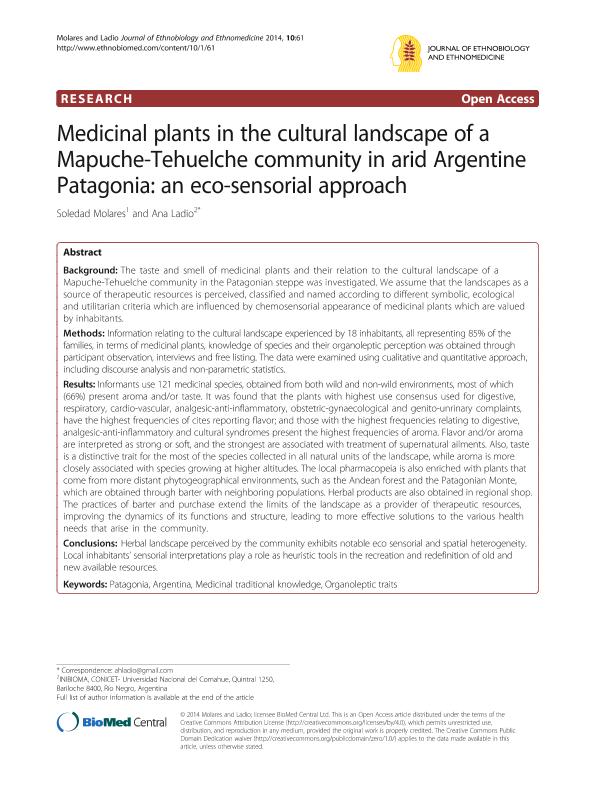Mostrar el registro sencillo del ítem
dc.contributor.author
Molares, Soledad

dc.contributor.author
Ladio, Ana Haydee

dc.date.available
2017-09-20T20:04:10Z
dc.date.issued
2014-08-26
dc.identifier.citation
Molares, Soledad; Ladio, Ana Haydee; Medicinal plants in the cultural landscape of a Mapuche-Tehuelche community in arid Argentine Patagonia: an eco-sensorial approach; BioMed Central; Journal of Ethnobiology and Ethnomedicine; 10; 61; 26-8-2014; 1-14
dc.identifier.issn
1746-4269
dc.identifier.uri
http://hdl.handle.net/11336/24740
dc.description.abstract
Background
The taste and smell of medicinal plants and their relation to the cultural landscape of a Mapuche-Tehuelche community in the Patagonian steppe was investigated. We assume that the landscapes as a source of therapeutic resources is perceived, classified and named according to different symbolic, ecological and utilitarian criteria which are influenced by chemosensorial appearance of medicinal plants which are valued by inhabitants.
Methods
Information relating to the cultural landscape experienced by 18 inhabitants, all representing 85% of the families, in terms of medicinal plants, knowledge of species and their organoleptic perception was obtained through participant observation, interviews and free listing. The data were examined using cualitative and quantitative approach, including discourse analysis and non-parametric statistics.
Results
Informants use 121 medicinal species, obtained from both wild and non-wild environments, most of which (66%) present aroma and/or taste. It was found that the plants with highest use consensus used for digestive, respiratory, cardio-vascular, analgesic-anti-inflammatory, obstetric-gynaecological and genito-unrinary complaints, have the highest frequencies of cites reporting flavor; and those with the highest frequencies relating to digestive, analgesic-anti-inflammatory and cultural syndromes present the highest frequencies of aroma. Flavor and/or aroma are interpreted as strong or soft, and the strongest are associated with treatment of supernatural ailments. Also, taste is a distinctive trait for the most of the species collected in all natural units of the landscape, while aroma is more closely associated with species growing at higher altitudes. The local pharmacopeia is also enriched with plants that come from more distant phytogeographical environments, such as the Andean forest and the Patagonian Monte, which are obtained through barter with neighboring populations. Herbal products are also obtained in regional shop. The practices of barter and purchase extend the limits of the landscape as a provider of therapeutic resources, improving the dynamics of its functions and structure, leading to more effective solutions to the various health needs that arise in the community.
Conclusions
Herbal landscape perceived by the community exhibits notable eco sensorial and spatial heterogeneity. Local inhabitants’ sensorial interpretations play a role as heuristic tools in the recreation and redefinition of old and new available resources.
dc.format
application/pdf
dc.language.iso
eng
dc.publisher
BioMed Central

dc.rights
info:eu-repo/semantics/openAccess
dc.rights.uri
https://creativecommons.org/licenses/by-nc-sa/2.5/ar/
dc.subject
Patagonia
dc.subject
Argentina
dc.subject
Medicinal Traditional Knowledge
dc.subject
Organoleptic Traits
dc.subject.classification
Ciencias Sociales Interdisciplinarias

dc.subject.classification
Otras Ciencias Sociales

dc.subject.classification
CIENCIAS SOCIALES

dc.subject.classification
Bioquímica y Biología Molecular

dc.subject.classification
Ciencias Biológicas

dc.subject.classification
CIENCIAS NATURALES Y EXACTAS

dc.title
Medicinal plants in the cultural landscape of a Mapuche-Tehuelche community in arid Argentine Patagonia: an eco-sensorial approach
dc.type
info:eu-repo/semantics/article
dc.type
info:ar-repo/semantics/artículo
dc.type
info:eu-repo/semantics/publishedVersion
dc.date.updated
2016-11-23T19:42:10Z
dc.journal.volume
10
dc.journal.number
61
dc.journal.pagination
1-14
dc.journal.pais
Reino Unido

dc.journal.ciudad
London
dc.description.fil
Fil: Molares, Soledad. Universidad Nacional de la Patagonia; Argentina
dc.description.fil
Fil: Ladio, Ana Haydee. Consejo Nacional de Investigaciones Científicas y Técnicas. Centro Científico Tecnológico Conicet - Patagonia Norte. Instituto de Investigaciones en Biodiversidad y Medioambiente. Universidad Nacional del Comahue. Centro Regional Universidad Bariloche. Instituto de Investigaciones en Biodiversidad y Medioambiente; Argentina
dc.journal.title
Journal of Ethnobiology and Ethnomedicine
dc.relation.alternativeid
info:eu-repo/semantics/altIdentifier/url/https://ethnobiomed.biomedcentral.com/articles/10.1186/1746-4269-10-61
dc.relation.alternativeid
info:eu-repo/semantics/altIdentifier/doi/http://dx.doi.org/10.1186/1746-4269-10-61
Archivos asociados
